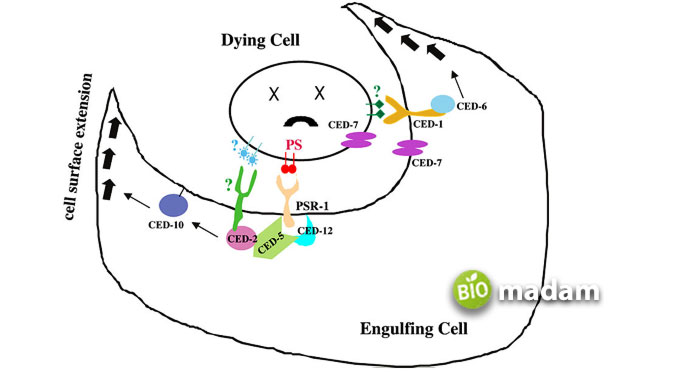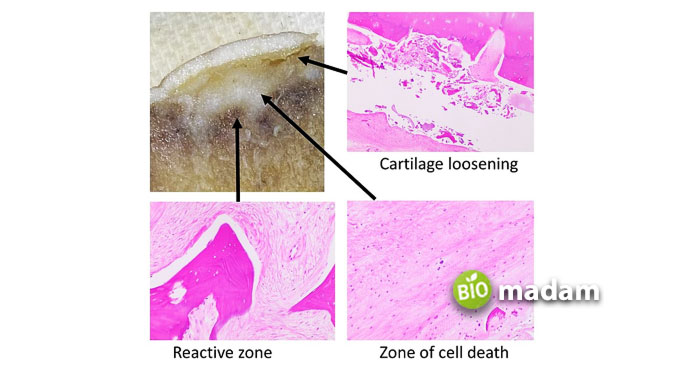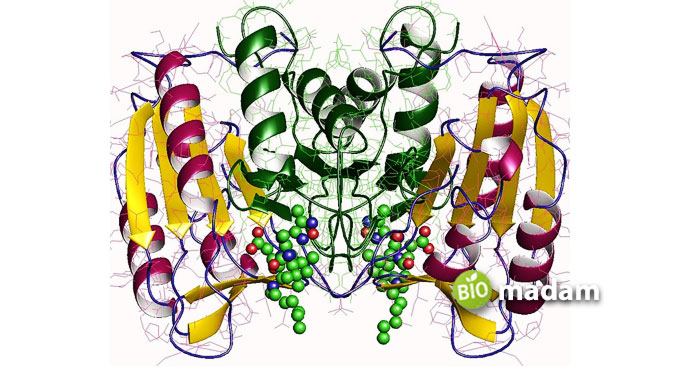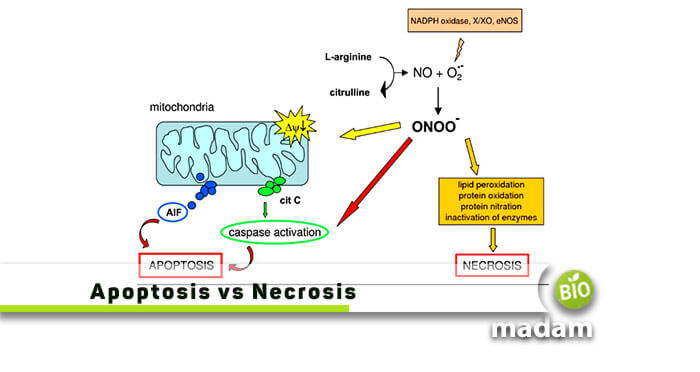Every living multicellular organism encounters different developmental and death processes. So, it’s imperative to grab the difference between apoptosis and necrosis. The durability and growth of living entities have major procedures that help them in a healthy lifestyle. All cells undergo death cycles in two different forms. It is either by the unfavorable environment or through a programmed series named necrosis and apoptosis.
A biological phenomenon resulting in cell death is called apoptosis. While, sudden cell death after getting affected by environmental factors (virus, bacteria, or fungus) or any injury is called necrosis.
Comparison Chart
| Basis of Comparison | Apoptosis | Necrosis |
| Site of Action | Attacks individual body cells | Attacks an entire group of cell |
| Inflammation | Lacks inflammation | Inflammation occurs |
| Shrinking/Swelling | Cell death occurs by shrinking | Cell death occurs by swelling |
| Energy Requirement | Requires energy in the form of ATP | No energy requirement |
| Effect on Chromatin | Chromatin assembles/condenses | No visual chromatin alteration |
| Type of DNA Digestion | Prelytic | Postlytic |
| Beneficial/Harmful | Beneficial | Harmful |
Apoptosis – Brief Explanation
A cellular destruction method that is already programmed in the body is called apoptosis. Many different chemical, biological, and environmental factors influence this process. This energy-triggered mechanism is regulated by an enzyme called protease (caspase) and obeys a few steps. The process initiates when a specific cell schedules suicide. It sends the message to the caspases, which activate to shrink the cell. Then the cell protrudes into a bubble-like shape so that the cellular substances can expel themselves. Furthermore, the caspases also induce DNases to eliminate the DNA in the cell’s nucleus.
A cell may not be needed by a body, so it undergoes apoptosis. Similarly, many reasons are promoting the apoptotic process, including maintaining the number of cells or eliminating the abnormally grown cells.

Necrosis – Brief Explanation
Spontaneous or unplanned cell death in a body refers to necrosis. There are multiple reasons for necrosis, including toxicity, infection, diseases, fungus, injuries, bacteria, etc. Moreover, some studies revealed that an influential cause behind necrosis is hypoxia. It is the decrease in oxygen supply to surrounding tissues.
The process begins when a cell couldn’t handle homeostasis. Hence, all the excess water and extracellular ions enter a cell, and it gets ruptured. It ultimately results in the bursting and loss of a cell.

Know the Differences Between Apoptosis & Necrosis
Definition
Apoptosis
Natural, programmed cell destruction is called apoptosis.
Necrosis
Necrosis is the unplanned or premature sudden death of a cell.
Procedure
Apoptosis
This organized death procedure begins after the cell’s cytoplasm shrinks with its nucleus condenses.
Necrosis
When a cell suddenly swells up due to unwanted factors, it follows the cell lysis, and necrosis occurs.
Leading Cause
Apoptosis
It is a natural phenomenon that has to occur for the survival and growth of body cells.
Necrosis
Necrosis is nothing more than pathological death due to external elements, such as infections, bacteria, viruses, trauma, and toxins (exotoxins).
Formation of Vesicles
Apoptosis
The process involves the formation of apoptotic bodies, which are membrane-encircled vesicles. These vesicles help in converting a cell into smaller bodies for further steps.
Necrosis
The method doesn’t require any vesicle formation, but the death occurs abruptly through cell lysis. It expels all the cell material out of it, and death occurs.
How The Cell’s Organelles React?
The cell organelles, mitochondria, vacuoles, and lysosomes are involved in the entire process, such as:
Apoptosis
When the cell starts shrinking, mitochondria leak their content, the lysosomes remain the same.
Necrosis
When the cell swells up, the lysosomes leak their content keeping the mitochondria in the same state.
Dependency of Pathway

Apoptosis
This cycle depends on caspase enzymes.
Necrosis
There is no involvement of caspase enzymes in necrosis.
ATP Requirement
Apoptosis
It requires a sufficient amount of energy due to being an active process.
Necrosis
This procedure doesn’t include ATP requirements due to being inactive.
DNA Fragmentation
Apoptosis
Apoptosis manages the prelytic DNA fragmentation process.
Necrosis
Necrosis manages the postlytic DNA fragmentation process.
Obvious Symptoms
Apoptosis
Apoptosis, being a conventional cell death procedure, doesn’t cause any destruction or prominent inflammation.
Necrosis
Being an accidental procedure, necrosis may damage the body tissues, like epithelial and connective tissues, and also produces inflammatory reactions.
How Does it Affect Our Body?
Apoptosis
This process is, most of the time, advantageous and helps in the development of body cells.
Necrosis
It can be destructive to a body, ultimately leading to death.
Key Role
Apoptosis
Apoptosis plays a principal part in regulating the number of cells in an organism.
Necrosis
It directly affects the tissues and damages them. Moreover, necrosis can sometimes defend the body against harmful pathogens as well.
Conclusion
So now you must have understood the difference between apoptosis and necrosis from the description above. Although both are cell death procedures, one is a natural phenomenon while the other is triggered by environmental factors. Apoptosis is a beneficial process, promotes the growth of body cells. On the other hand, necrosis may be harmful to body tissues as it damages them.

Hello, I would like to introduce myself to you! I am Chelsea Rogers, an experienced blog writer for science articles, holding an MPhil degree. My enthusiasm to grab the best knowledge, let it relate to botany, zoology, or any other science branch. Read my articles & let me wait for your words s in the comment section.

